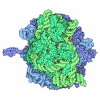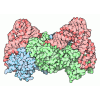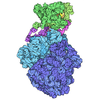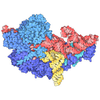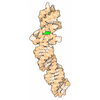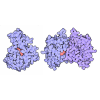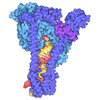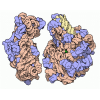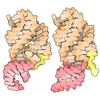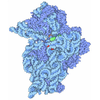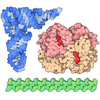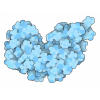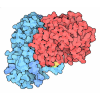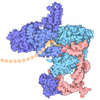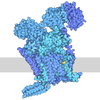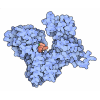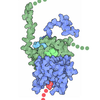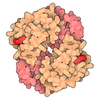+ Open data
Open data
- Basic information
Basic information
| Entry | Database: PDB / ID: 6n7r | |||||||||||||||
|---|---|---|---|---|---|---|---|---|---|---|---|---|---|---|---|---|
| Title | Saccharomyces cerevisiae spliceosomal E complex (ACT1) | |||||||||||||||
 Components Components |
| |||||||||||||||
 Keywords Keywords | RNA BINDING PROTEIN / pre-mRNA splicing / spliceosome / E complex | |||||||||||||||
| Function / homology |  Function and homology information Function and homology informationmRNA splice site recognition / U4/U6 snRNP / 7-methylguanosine cap hypermethylation / pICln-Sm protein complex / snRNP binding / positive regulation of mRNA splicing, via spliceosome / small nuclear ribonucleoprotein complex / splicing factor binding / SMN-Sm protein complex / spliceosomal tri-snRNP complex ...mRNA splice site recognition / U4/U6 snRNP / 7-methylguanosine cap hypermethylation / pICln-Sm protein complex / snRNP binding / positive regulation of mRNA splicing, via spliceosome / small nuclear ribonucleoprotein complex / splicing factor binding / SMN-Sm protein complex / spliceosomal tri-snRNP complex / commitment complex / U2-type prespliceosome assembly / U2 snRNP / U1 snRNP / U4 snRNP / poly(U) RNA binding / U2-type prespliceosome / pre-mRNA 5'-splice site binding / precatalytic spliceosome / mRNA 5'-splice site recognition / spliceosomal complex assembly / Prp19 complex / U5 snRNP / spliceosomal snRNP assembly / U1 snRNA binding / U4/U6 x U5 tri-snRNP complex / catalytic step 2 spliceosome / spliceosomal complex / mRNA splicing, via spliceosome / mRNA binding / RNA binding / zinc ion binding / nucleus / cytosol / cytoplasm Similarity search - Function | |||||||||||||||
| Biological species |   | |||||||||||||||
| Method | ELECTRON MICROSCOPY / single particle reconstruction / cryo EM / Resolution: 3.2 Å | |||||||||||||||
 Authors Authors | Liu, S. / Li, X. / Zhou, Z.H. / Zhao, R. | |||||||||||||||
| Funding support |  United States, 4items United States, 4items
| |||||||||||||||
 Citation Citation |  Journal: Nature / Year: 2019 Journal: Nature / Year: 2019Title: A unified mechanism for intron and exon definition and back-splicing. Authors: Xueni Li / Shiheng Liu / Lingdi Zhang / Aaron Issaian / Ryan C Hill / Sara Espinosa / Shasha Shi / Yanxiang Cui / Kalli Kappel / Rhiju Das / Kirk C Hansen / Z Hong Zhou / Rui Zhao /  Abstract: The molecular mechanisms of exon definition and back-splicing are fundamental unanswered questions in pre-mRNA splicing. Here we report cryo-electron microscopy structures of the yeast spliceosomal E ...The molecular mechanisms of exon definition and back-splicing are fundamental unanswered questions in pre-mRNA splicing. Here we report cryo-electron microscopy structures of the yeast spliceosomal E complex assembled on introns, providing a view of the earliest event in the splicing cycle that commits pre-mRNAs to splicing. The E complex architecture suggests that the same spliceosome can assemble across an exon, and that it either remodels to span an intron for canonical linear splicing (typically on short exons) or catalyses back-splicing to generate circular RNA (on long exons). The model is supported by our experiments, which show that an E complex assembled on the middle exon of yeast EFM5 or HMRA1 can be chased into circular RNA when the exon is sufficiently long. This simple model unifies intron definition, exon definition, and back-splicing through the same spliceosome in all eukaryotes and should inspire experiments in many other systems to understand the mechanism and regulation of these processes. | |||||||||||||||
| History |
|
- Structure visualization
Structure visualization
| Movie |
 Movie viewer Movie viewer |
|---|---|
| Structure viewer | Molecule:  Molmil Molmil Jmol/JSmol Jmol/JSmol |
- Downloads & links
Downloads & links
- Download
Download
| PDBx/mmCIF format |  6n7r.cif.gz 6n7r.cif.gz | 840.3 KB | Display |  PDBx/mmCIF format PDBx/mmCIF format |
|---|---|---|---|---|
| PDB format |  pdb6n7r.ent.gz pdb6n7r.ent.gz | 638.4 KB | Display |  PDB format PDB format |
| PDBx/mmJSON format |  6n7r.json.gz 6n7r.json.gz | Tree view |  PDBx/mmJSON format PDBx/mmJSON format | |
| Others |  Other downloads Other downloads |
-Validation report
| Summary document |  6n7r_validation.pdf.gz 6n7r_validation.pdf.gz | 1.1 MB | Display |  wwPDB validaton report wwPDB validaton report |
|---|---|---|---|---|
| Full document |  6n7r_full_validation.pdf.gz 6n7r_full_validation.pdf.gz | 1.1 MB | Display | |
| Data in XML |  6n7r_validation.xml.gz 6n7r_validation.xml.gz | 87 KB | Display | |
| Data in CIF |  6n7r_validation.cif.gz 6n7r_validation.cif.gz | 146.3 KB | Display | |
| Arichive directory |  https://data.pdbj.org/pub/pdb/validation_reports/n7/6n7r https://data.pdbj.org/pub/pdb/validation_reports/n7/6n7r ftp://data.pdbj.org/pub/pdb/validation_reports/n7/6n7r ftp://data.pdbj.org/pub/pdb/validation_reports/n7/6n7r | HTTPS FTP |
-Related structure data
| Related structure data |  0361MC  0360C  6n7pC C: citing same article ( M: map data used to model this data |
|---|---|
| Similar structure data |
- Links
Links
- Assembly
Assembly
| Deposited unit | 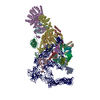
|
|---|---|
| 1 |
|
- Components
Components
-U1 small nuclear ribonucleoprotein ... , 5 types, 5 molecules ABCDH
| #1: Protein | Mass: 34506.148 Da / Num. of mol.: 1 / Source method: isolated from a natural source Source: (natural)  Strain: ATCC 204508 / S288c / References: UniProt: Q00916 |
|---|---|
| #2: Protein | Mass: 27106.016 Da / Num. of mol.: 1 / Source method: isolated from a natural source Source: (natural)  Strain: ATCC 204508 / S288c / References: UniProt: Q05900 |
| #3: Protein | Mass: 40413.961 Da / Num. of mol.: 1 Source method: isolated from a genetically manipulated source Source: (gene. exp.)  Strain: ATCC 204508 / S288c Production host:  Strain (production host): ATCC 204508 / S288c / References: UniProt: P32605 |
| #4: Protein | Mass: 65222.020 Da / Num. of mol.: 1 / Source method: isolated from a natural source Source: (natural)  Strain: ATCC 204508 / S288c / References: UniProt: Q03776 |
| #8: Protein | Mass: 9123.642 Da / Num. of mol.: 1 / Source method: isolated from a natural source Source: (natural)   Strain: ATCC 204508 / S288c / References: UniProt: P53207 |
-Protein , 5 types, 5 molecules EFGIK
| #5: Protein | Mass: 74834.742 Da / Num. of mol.: 1 / Source method: isolated from a natural source Source: (natural)  Strain: ATCC 204508 / S288c / References: UniProt: P39682 |
|---|---|
| #6: Protein | Mass: 57010.840 Da / Num. of mol.: 1 / Source method: isolated from a natural source Source: (natural)  Strain: ATCC 204508 / S288c / References: UniProt: Q00539 |
| #7: Protein | Mass: 56575.277 Da / Num. of mol.: 1 / Source method: isolated from a natural source Source: (natural)  Strain: ATCC 204508 / S288c / References: UniProt: Q03782 |
| #9: Protein | Mass: 30245.885 Da / Num. of mol.: 1 / Source method: isolated from a natural source Source: (natural)  Strain: ATCC 204508 / S288c / References: UniProt: Q07508 |
| #10: Protein | Mass: 22426.990 Da / Num. of mol.: 1 / Source method: isolated from a natural source Source: (natural)  Strain: ATCC 204508 / S288c / References: UniProt: P40018 |
-Small nuclear ribonucleoprotein ... , 6 types, 6 molecules LMNOPQ
| #11: Protein | Mass: 16296.798 Da / Num. of mol.: 1 / Source method: isolated from a natural source Source: (natural)  Strain: ATCC 204508 / S288c / References: UniProt: Q02260 |
|---|---|
| #12: Protein | Mass: 12876.066 Da / Num. of mol.: 1 / Source method: isolated from a natural source Source: (natural)  Strain: ATCC 204508 / S288c / References: UniProt: Q06217 |
| #13: Protein | Mass: 11240.139 Da / Num. of mol.: 1 / Source method: isolated from a natural source Source: (natural)  Strain: ATCC 204508 / S288c / References: UniProt: P43321 |
| #14: Protein | Mass: 10385.098 Da / Num. of mol.: 1 / Source method: isolated from a natural source Source: (natural)  Strain: ATCC 204508 / S288c / References: UniProt: Q12330 |
| #15: Protein | Mass: 9669.945 Da / Num. of mol.: 1 / Source method: isolated from a natural source Source: (natural)  Strain: ATCC 204508 / S288c / References: UniProt: P54999 |
| #16: Protein | Mass: 8490.809 Da / Num. of mol.: 1 / Source method: isolated from a natural source Source: (natural)  Strain: ATCC 204508 / S288c / References: UniProt: P40204 |
-RNA chain , 2 types, 2 molecules Rr
| #17: RNA chain | Mass: 182114.516 Da / Num. of mol.: 1 / Source method: isolated from a natural source / Source: (natural)  |
|---|---|
| #18: RNA chain | Mass: 70171.188 Da / Num. of mol.: 1 / Source method: obtained synthetically / Source: (synth.)  |
-Non-polymers , 1 types, 1 molecules 
| #19: Chemical | ChemComp-ZN / |
|---|
-Details
| Has ligand of interest | N |
|---|
-Experimental details
-Experiment
| Experiment | Method: ELECTRON MICROSCOPY |
|---|---|
| EM experiment | Aggregation state: PARTICLE / 3D reconstruction method: single particle reconstruction |
- Sample preparation
Sample preparation
| Component | Name: Saccharomyces cerevisiae spliceosomal E complex (ACT1) Type: COMPLEX / Entity ID: #1-#18 / Source: MULTIPLE SOURCES |
|---|---|
| Molecular weight | Experimental value: NO |
| Source (natural) | Organism:  |
| Buffer solution | pH: 7.9 |
| Specimen | Embedding applied: NO / Shadowing applied: NO / Staining applied: NO / Vitrification applied: YES |
| Specimen support | Details: unspecified |
| Vitrification | Cryogen name: ETHANE |
- Electron microscopy imaging
Electron microscopy imaging
| Experimental equipment |  Model: Titan Krios / Image courtesy: FEI Company |
|---|---|
| Microscopy | Model: FEI TITAN KRIOS |
| Electron gun | Electron source:  FIELD EMISSION GUN / Accelerating voltage: 300 kV / Illumination mode: FLOOD BEAM FIELD EMISSION GUN / Accelerating voltage: 300 kV / Illumination mode: FLOOD BEAM |
| Electron lens | Mode: BRIGHT FIELD |
| Image recording | Electron dose: 30 e/Å2 / Detector mode: SUPER-RESOLUTION / Film or detector model: GATAN K2 SUMMIT (4k x 4k) |
- Processing
Processing
| EM software |
| ||||||||||||||||||||||||||||
|---|---|---|---|---|---|---|---|---|---|---|---|---|---|---|---|---|---|---|---|---|---|---|---|---|---|---|---|---|---|
| CTF correction | Type: PHASE FLIPPING AND AMPLITUDE CORRECTION | ||||||||||||||||||||||||||||
| Symmetry | Point symmetry: C1 (asymmetric) | ||||||||||||||||||||||||||||
| 3D reconstruction | Resolution: 3.2 Å / Resolution method: FSC 0.143 CUT-OFF / Num. of particles: 270587 / Symmetry type: POINT |
 Movie
Movie Controller
Controller



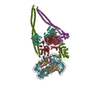

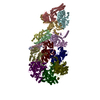





 PDBj
PDBj
